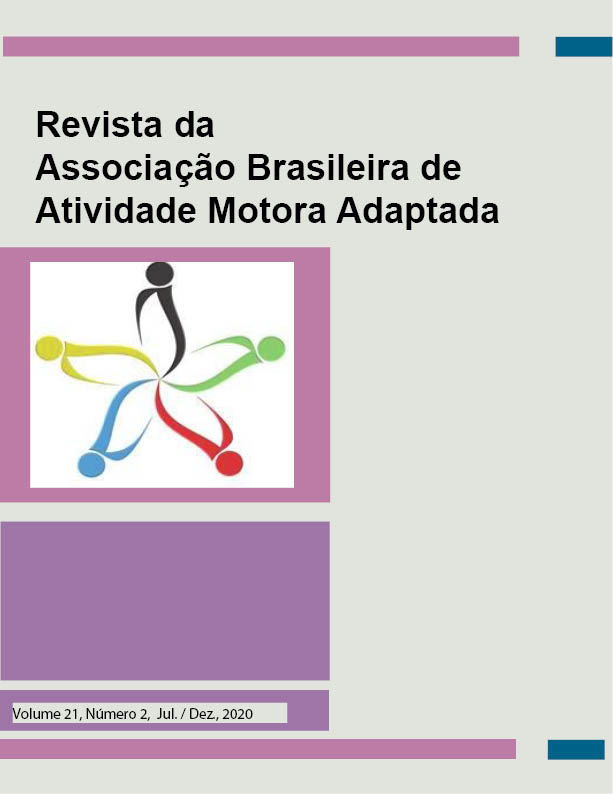BODY COMPOSITION PROFILE OF SEDENTARY INDIVIDUAL'S WITH SPINAL CORD INJURY THROUGH BIOELETRICAL IMPEDANCE ANALYSIS
DOI:
https://doi.org/10.36311/2674-8681.2020.v21n2.p247-256Keywords:
Adapted Motor Activity, Spinal Cord Injury, Body Composition, BioimpedanceAbstract
A spinal cord injury (SCI) is characterized as a traumatic condition that causes neurological damage and leads to changes in the body composition (BC) of an individual. Those changes in BC may increase risk of disease. The paper’s objetctive is to analize BC profile of sedentary individuals with spinal cord injury, comparing measurements of abdominal and waist circumferences, and verifying the aplicability of the bioelectrical impedance analysis (BIA). Descriptive study of transversal cut. 20 male individual’s samples with SCI. In order to analyze body fat percentage (%B) it was utilized a bio-impedancemetry body composition analyser, Maltron brand, model BF-900. For data analysis, it was used the Shapiro-Wilk test to test data normality and for data comparison between paraplegia and tetraplegia it was utilized the Student’s t test. Results: 45% are within adequate bodyweight, 50% are overweight and 5% and are class 1 obesity. The %B was divided as the folllowing: 10% were average, 45% above average and the other 45% were way above average. Conclusion: Indiviuals presented an elevated body fat percentage and were found to be overweight. BIA turned out to be a easy access method to measure BC.
Received on: 06/15/2020
Reformulated on: 07/08/2020
Accepted: 07/13/2020
References
BORGES, Mariane. Segmental body composition in athletes with spinal cord injury. Master Degree dissertation - Physical Education College. Universidade Estadual de Campinas, Campinas, 2015.
BRASIL. (2013). Ministério da Saúde. Secretaria da Atenção à Saúde. Diretrizes de atenção à pessoa com lesão medular. Brasília, DF.
BRONZERI, F.G.; e colaboradores. Mielomeningocele e nutrição: proposta de protocolo de atendimento. São Paulo. O Mundo Saúde. Vol.35. Núm.2. p.215-224. 2011.
BUCHHOLZ, A. C.; McGILLIVRAY, C. F.; PENCHARZ, P. B. Differences in resting metabolic rate between paraplegic and able-bodied subjects are explained by differences in body composition. The American Journal of Clinical Nutrition, v. 77, n.2, p. 371–8, 2009.
COUPAUD, S.; et al. Muscle and bone adaptations after treadmill training in incomplete Spinal Cord Injury: a case study using peripheral Quantitative Computed Tomography. Journal Musculoskelet Neuronal Interact. Kifissia, v. 4, n. 4, p. 288- 297, dez 2009.
EICKEMBERG, Michaela et, al; “Bioelectric impedance analysis and its use for nutritional assessments”. Rev. Nutr. vol.24 no.6 Campinas Nov./Dec. 2011.
EMMONS. R. R. et al. Assessment of Measures for Abdominal Adiposity in Persons with Spinal Cord Injury. Ultrasound in Med. & Biol. v. 37, n. 5, p. 734-741, 2011.
ERIKS-HOOGLAND, I. et al. Clinical assessment of obesity in persons with spinal cord injury: validity of waist circumference, body mass index, and anthropometric index. The Journal of Spinal Cord Medicine, v. 34, n. 4, p. 416-422, jul. 2011.
GATER, D.; CLASEY, J. Body composition assessment in spinal cord injury clinical trials. Topics in Spinal Cord Injury Rehabilitation, v. 11, n. 3 p. 36-49, 2006.
GORGEY, A. S.; MATHER, K. J; POARCH, H. J.; GATER, D. R. Influence of motor complete spinal cord injury on visceral and subcutaneous adipose tissue measured by multi-axial magnetic resonance imaging. The Journal of Spinal Cord Medicine, v.34, n. 1, p. 99-109, Jan. 2011.
GUEDES, D. P.; GUEDES, J. E. R. P. Manual prático para avaliação: em educação física. Barueri: Manole, 2006. 484p.
LAUGHTON, G., BUCHHOLZ, A., MARTIN GINIS, K. et al. Lowering body mass index cutoffs better identifies obese persons with spinal cord injury. Spinal Cord 47, 757–762 2009.
LOHMAN, T. G. Advances in body composition assessment. Chanpagnain: Human Kinetics Books, 1992. 160 p.
MORENO-FERGUSSON ME, MAYA REY MC. Cuerpo y corporalidad en la paraplejia: significado de los cambios. Av. enferm. 2012; XXX(1):82-94.
NETO, F. R.; LOPES, G. H. R.; Análise dos valores de composição corporal em homens com diferentes níveis de lesão medular. Fisioter. Mov., Curitiba, v. 26, n. 4, p. 743-752, set./dez. 2013.
OMS - Organização Mundial da Saúde -. Obesity and overweight and what is the scale of the obesity problem in your country? Report of a WHO consultation on obesity. 2006. Disponível em: <http://www.who.int/infobase/report.aspx?rid=118.
RAVENSBERGEN, H. J. C.; LEAR, S. A.; CLAYDON; V. E. Waist circumference is the best index for obesity-related cardiovascular disease risk in individuals with spinal cord injury. Journal of Neurotrauma. p. 1-34, 2013.
SPUNGEN, A. M. et al. Factor is influencing body composition in persons with spinal cord injury: a cross-sectional study. Journal of Applied Physiology, v. 95, n. 6, p. 2398–2407, Dec. 2003.
VEEGER, H. E. J. et al. Peak oxygen uptake and maximal power output Olympic wheelchair-dependent athletes. Med Sci Sports Exerc. v. 23, n. 10, p.1201-1209, 1991.
YARAR-FISHER C., Y. CHEN, AB JACKSON, GR HUNTER. O índice de massa corporal subestima a adiposidade em mulheres com lesão medular. A obesidade (Silver Spring), 21 (6) (2013), pp. 1223 – 1.




